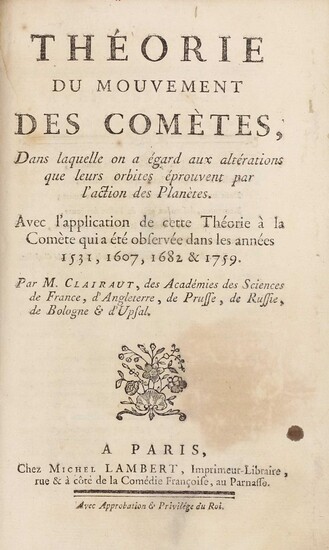Théorie du mouvement des comètes, dans laquelle on a égard aux altérations que leurs orbites éprouvent par l'action des planètes. Avec l'application de cette théorie à la comète qui a été observée dans les années 1531, 1607, 1682 & 1759.
By CLAIRAUT, Alexis Claude
8vo (196 x 125 mm). [2] i-xiv, [1] 2-247 [1] pp. Woodcut device on title, letterpress tables, 2 folding engraved plates bound at the end. Contemporary French mottled calf, spine with 5 raised bands, gilt decoration and gilt-lettered red morocco label, red-dyed edges, marbled endpapers (joints partially split, some worming to spine, foot of spine scuffed, extremities rubbed, marinal browning of flyleaves from binders glue). Text little browned, occasional minor spotting, small ink spot and light brown stain to title-page). Provenance: Giancarlo Beltrame Library. All in all a very good copy. ---- Norman 487; Freitag 483; DSB III, p.283. - FIRST EDITION, EXCEPTIONAL RARE, especially with the folding plates. In the work 'Théorie du mouvement des comètes' ('Theory on the Movement of Comets') Clairaut predicted the date that Halley's comet would be nearest the sun, was April 13, 1759. The actual date was March 13, just within the allowed-for margins of error. There was a suggestion that Halley's Comet be renamed for Clairaut and he was hailed as the "new Thales." "In the 1740s Clairaut became the first to find an approximate resolution of the three-body problem when he calculated the movement of the moon's apogee using an augmented version of Newton's law of attraction. In the 1750s he turned his attention to the movement of comets, inspired by Halley's prediction of 1705 that the comet last observed in 1682 would appear in 1758 or 1759. Halley had attributed the variations in the comet's period of appearance to pertubations caused by Jupiter and Saturn, and Clairaut, armed with his solution to the three-body problem, set out to calculate these pertubations in order to predict the exact time of the comet's passage to perihelion. In November 1758, he announced that the passage would occur around 15 Aril 1759; the actual passage took place on 13 March. Clairaut afterward refined his calculations to arrive at the date 4 April, and later, by use of different method, the last day of March - a calculation which no one at the time could have bettered." (Norman 487). - Visit our website for additional images and information.
Published by: Chez Michel Lambert, Paris, 1760
Vendor: Milestones of Science Books
Buy Now on
By CLAIRAUT, Alexis Claude
8vo (196 x 125 mm). [2] i-xiv, [1] 2-247 [1] pp. Woodcut device on title, letterpress tables, 2 folding engraved plates bound at the end. Contemporary French mottled calf, spine with 5 raised bands, gilt decoration and gilt-lettered red morocco label, red-dyed edges, marbled endpapers (joints partially split, some worming to spine, foot of spine scuffed, extremities rubbed, marinal browning of flyleaves from binders glue). Text little browned, occasional minor spotting, small ink spot and light brown stain to title-page). Provenance: Giancarlo Beltrame Library. All in all a very good copy. ---- Norman 487; Freitag 483; DSB III, p.283. - FIRST EDITION, EXCEPTIONAL RARE, especially with the folding plates. In the work 'Théorie du mouvement des comètes' ('Theory on the Movement of Comets') Clairaut predicted the date that Halley's comet would be nearest the sun, was April 13, 1759. The actual date was March 13, just within the allowed-for margins of error. There was a suggestion that Halley's Comet be renamed for Clairaut and he was hailed as the "new Thales." "In the 1740s Clairaut became the first to find an approximate resolution of the three-body problem when he calculated the movement of the moon's apogee using an augmented version of Newton's law of attraction. In the 1750s he turned his attention to the movement of comets, inspired by Halley's prediction of 1705 that the comet last observed in 1682 would appear in 1758 or 1759. Halley had attributed the variations in the comet's period of appearance to pertubations caused by Jupiter and Saturn, and Clairaut, armed with his solution to the three-body problem, set out to calculate these pertubations in order to predict the exact time of the comet's passage to perihelion. In November 1758, he announced that the passage would occur around 15 Aril 1759; the actual passage took place on 13 March. Clairaut afterward refined his calculations to arrive at the date 4 April, and later, by use of different method, the last day of March - a calculation which no one at the time could have bettered." (Norman 487). - Visit our website for additional images and information.
Published by: Chez Michel Lambert, Paris, 1760
Vendor: Milestones of Science Books



